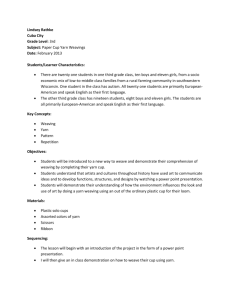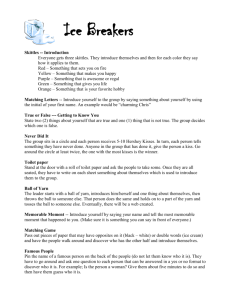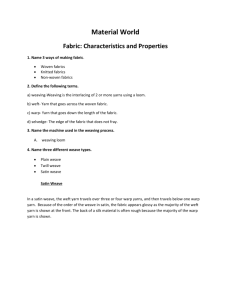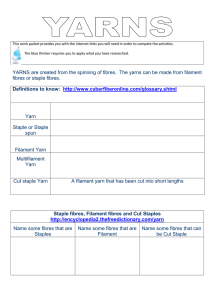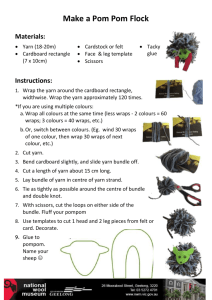Study on the Properties of Core Spun Yarn Lu Jing, Jinlian Hu
advertisement
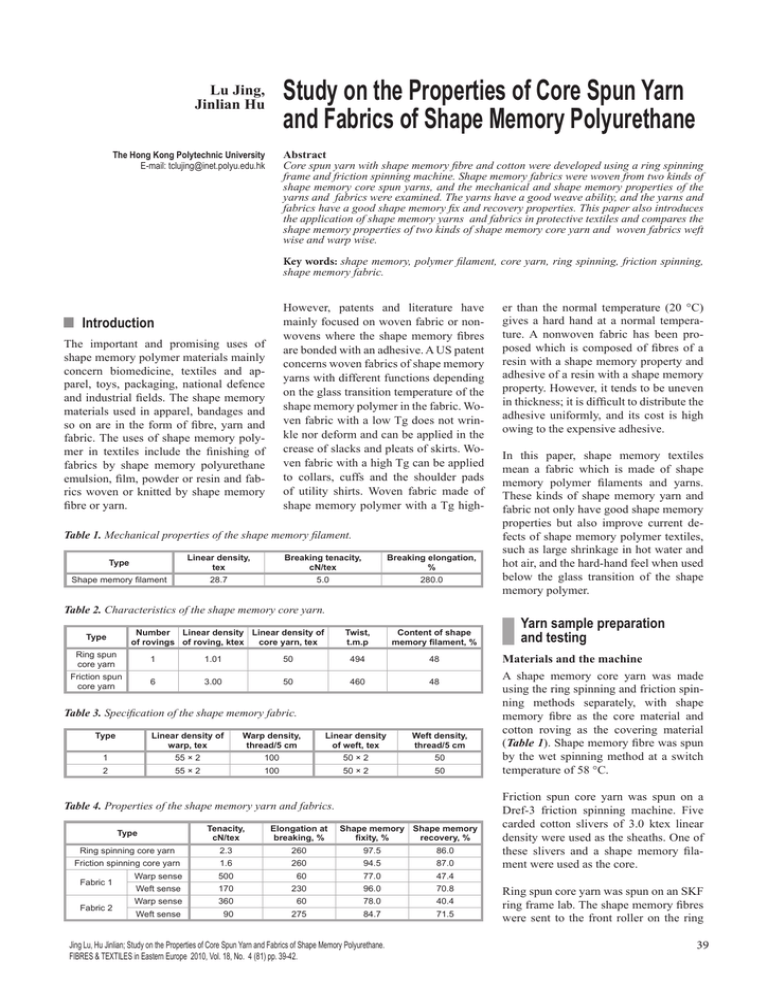
Study on the Properties of Core Spun Yarn and Fabrics of Shape Memory Polyurethane Lu Jing, Jinlian Hu Abstract Core spun yarn with shape memory fibre and cotton were developed using a ring spinning frame and friction spinning machine. Shape memory fabrics were woven from two kinds of shape memory core spun yarns, and the mechanical and shape memory properties of the yarns and fabrics were examined. The yarns have a good weave ability, and the yarns and fabrics have a good shape memory fix and recovery properties. This paper also introduces the application of shape memory yarns and fabrics in protective textiles and compares the shape memory properties of two kinds of shape memory core yarn and woven fabrics weft wise and warp wise. The Hong Kong Polytechnic University E-mail: tclujing@inet.polyu.edu.hk Key words: shape memory, polymer filament, core yarn, ring spinning, friction spinning, shape memory fabric. However, patents and literature have mainly focused on woven fabric or nonwovens where the shape memory fibres are bonded with an adhesive. A US patent concerns woven fabrics of shape memory yarns with different functions depending on the glass transition temperature of the shape memory polymer in the fabric. Woven fabric with a low Tg does not wrinkle nor deform and can be applied in the crease of slacks and pleats of skirts. Woven fabric with a high Tg can be applied to collars, cuffs and the shoulder pads of utility shirts. Woven fabric made of shape memory polymer with a Tg high- n Introduction The important and promising uses of shape memory polymer materials mainly concern biomedicine, textiles and apparel, toys, packaging, national defence and industrial fields. The shape memory materials used in apparel, bandages and so on are in the form of fibre, yarn and fabric. The uses of shape memory polymer in textiles include the finishing of fabrics by shape memory polyurethane emulsion, film, powder or resin and fabrics woven or knitted by shape memory fibre or yarn. Table 1. Mechanical properties of the shape memory filament. Type Linear density, tex Breaking tenacity, cN/tex Breaking elongation, % Shape memory filament 28.7 5.0 280.0 Table 2. Characteristics of the shape memory core yarn. Number Linear density Linear density of of rovings of roving, ktex core yarn, tex Type Twist, t.m.p Content of shape memory filament, % Ring spun core yarn 1 1.01 50 494 48 Friction spun core yarn 6 3.00 50 460 48 Table 3. Specification of the shape memory fabric. Type Linear density of warp, tex Warp density, thread/5 cm Linear density of weft, tex Weft density, thread/5 cm 1 55 × 2 100 50 × 2 50 2 55 × 2 100 50 × 2 50 Table 4. Properties of the shape memory yarn and fabrics. Type Tenacity, cN/tex Elongation at breaking, % Shape memory Shape memory fixity, % recovery, % Ring spinning core yarn 2.3 260 97.5 86.0 Friction spinning core yarn 1.6 260 94.5 87.0 Warp sense 500 60 77.0 47.4 Weft sense 170 230 96.0 70.8 Warp sense 360 60 78.0 40.4 Weft sense 90 275 84.7 71.5 Fabric 1 Fabric 2 Jing Lu, Hu Jinlian; Study on the Properties of Core Spun Yarn and Fabrics of Shape Memory Polyurethane. FIBRES & TEXTILES in Eastern Europe 2010, Vol. 18, No. 4 (81) pp. 39-42. er than the normal temperature (20 °C) gives a hard hand at a normal temperature. A nonwoven fabric has been proposed which is composed of fibres of a resin with a shape memory property and adhesive of a resin with a shape memory property. However, it tends to be uneven in thickness; it is difficult to distribute the adhesive uniformly, and its cost is high owing to the expensive adhesive. In this paper, shape memory textiles mean a fabric which is made of shape memory polymer filaments and yarns. These kinds of shape memory yarn and fabric not only have good shape memory properties but also improve current defects of shape memory polymer textiles, such as large shrinkage in hot water and hot air, and the hard-hand feel when used below the glass transition of the shape memory polymer. Yarn sample preparation and testing Materials and the machine A shape memory core yarn was made using the ring spinning and friction spinning methods separately, with shape memory fibre as the core material and cotton roving as the covering material (Table 1). Shape memory fibre was spun by the wet spinning method at a switch temperature of 58 °C. Friction spun core yarn was spun on a Dref-3 friction spinning machine. Five carded cotton slivers of 3.0 ktex linear density were used as the sheaths. One of these slivers and a shape memory filament were used as the core. Ring spun core yarn was spun on an SKF ring frame lab. The shape memory fibres were sent to the front roller on the ring 39 n Results and discussion Table 4 shows the properties of the shape memory yarn and fabrics. Figure 1. Stress-strain curve of the shape memory core yarn. spinning frame, were stable at the center of the spinning triangular space and could be covered with cotton fibres completely. Cotton fibres were first drafted from the back roller through the middle roller and were then drafted from the middle roller through the front roller on the ring spinning frame. The shape memory fibres were covered and twisted with polyester staple fibres in the spinning triangular space to form core spun shape memory yarn, which was then taken-up on a ring bobbin by a spindle. Table 2 lists the characteristics of these two kinds of shape memory core yarn. Testing Fabric weaving The shape memory properties of the fibre, core yarn and fabrics were tested on the Instron 4466 material machine with temperature control equipment by the method in reference [3]. The shape memory recovery temperature was 70 °C, and the shape memory fixity temperature was 21 °C. Twill fabrics were woven using cotton yarn as the warp and shape memory core yarn as the weft. Fabric 1 was woven with ring spun core yarn as the weft and fabric 2 with friction core yarn as the warp. Table 3 lists the specifications of these shape memory fabrics. a) Strain, % The tenacity of the shape memory fibre and core yarn were tested on an Instron 4466 material testing machine in a standard atmosphere environment. The testing velocity was 10 mm/min. The breaking strength and elongation of the shape memory fabrics were tested on an Instron 4466 material testing machine in a standard atmosphere environment using the ravelled strip test. The length of the sample was 20 cm, the width - 2 cm and the testing velocity was 30 mm/min. b) Figure 1 shows stress-strain curves of two kinds of shape memory core yarn. Table 4 and Figure 1 shows that the elongation at break of the shape memory fibre is larger than that of the two kinds of core yarns because of some extraction of shape memory fibre during spinning. There are some differences in the mechanical properties of the two kinds of shape memory core yarns. As Figure 1 shows, the tenacity of the ring core yarn is larger than those of the friction core yarn, but the elongation is the same. The difference in the properties is more dependent on the difference in core spun yarn structure. In comparison with other yarns, ring spun yarn is the strongest and has the shortest failure zone length at longer gauge lengths. The interlocking of fibres provided by better migration of fibres in ring spun yarn in comparison with other yarns [3] enhances the gripping of the fibre bundle; hence, ring yarn is the strongest at longer gauge lengths. Friction spun yarn appears similar to ring spun yarn visually, but its internal structure differs from that of ring spun yarn. The internal structure of friction spun yarn is characterised by its inferior fibre orientation, looped and buckled fibre configuration, as well as by the loose packing of fibres, associated with low tension during yarn formation. This yarn has a significantly larger number of different types of hooks that are very long; therefore there is a large reduction in the Strain, % Figure 2. Tenacity-strain curves of the shape memory fabrics; a) warp sense, b) weft sense. 40 FIBRES & TEXTILES in Eastern Europe 2010, Vol. 18, No. 4 (81) Figure 3. Diagrammatic sketch of the shape memory tensile test curves. proportion of straight fibres and average fibre extent in the yarn, which is due to the buckling of fibres as they reach the spinning drum. Friction spun yarn exhibits a layer type of structure because the fibres are fed to the yarn tail in a different position along its length without tension. Therefore, the fibres lie along the yarn tail at necessarily different radial positions, such that their radial positions increase along the yarn-take-up direction. As a result, some fibres appear on the yarn surface and others closer to the yarn centre. The average number of fibres in the friction spinning was lower in comparison with the other yarns, in spite of this yarn being coarser than the other ones. The average helix angle of fibres in this yarn was 30.3°, which is substantially higher than others. This higher helix angle of fibres is responsible for the low number of fibres in the yarn crosssection. Friction spun yarn is bulkier, and fibres in this yarn are the most loosely packed. When tense, the internal tight fibre of friction yarn and shape memory fibre mainly bear the strength, and the outer loose fibre has low strength due to slippage. Ring spun yarn has an average structure and can bear the strength at the same time, presenting higher strength than friction spun yarn. Under tension, the out fibres break or disintegrate when the strength is low. After the cotton fibre disintegrates, the shape memory fibre undergoes a tensile load. Figure 1 also shows that shape memory fibre is the main part taking the load. In Figure 1, there is a yield point on the stress-strain curves. The yield point stress has a larger influence on the fabrics than the breaking tenacity when they are woven. Under the same woven parameters, fabric with friction core yarn has wrinkles and an uneven surface, whereas fabric with ring spun yarn has a flat surface. FIBRES & TEXTILES in Eastern Europe 2010, Vol. 18, No. 4 (81) Figure 2 shows the tenacity-strain curves of the fabrics in the warp (Figure 2.a) and weft (Figure 2.b). The two kinds of fabrics have the same warp density. The warp wise tensile strength presents the properties of cotton yarn. From Figure 2.a, the two kinds of fabrics have the same breaking tenacity and breaking elongation. Figure 2.b shows that the fabric with ring spun yarn has a higher tenacity and lower breaking elongation because ring spun yarn has a higher tenacity than that of friction yarn, as presented in Figure 1. Table 3 shows the shape memory fixity and recovery of shape memory yarn and fabrics obtained by the method in reference [3]. The shape memory yarn specimen was 10 threads of yarns parallel to one another. The shape memory fabric specimen was 1 cm wide along the warp and weft. The test gauge was 25 mm. The experimental apparatus comprised a tensile machine with a constant temperature control chamber. The elongation of the specimen was measured by the displacement of the crosshead. The clamping portion of the fixture for the specimen had a wavelike surface to prevent slippage. Details of the test process are as follows and presented in Figure 3: 1) At a temperature of 70 °C, which was higher than the switch temperature of the shape memory fibre, the maximum strain εm was applied at a constant rate of 10 mm/min; 2) maintaining εm, the specimen was cooled to 21 °C. After holding at 21 °C for 5 min, the specimen was unloaded and the crosshead returned to its initial position. 3) it was heated from 21 °C to 70 °C under no load condition, and the second tensile cycle was started. According to the experiment, the tensile cycle has the same curve shape after the second cycle. Hence, there is only the first cycle and the second test cycle curve in the shape memory curve figures. The shape memory fixity Rf and shape a) b) c) d) e) f) Figure 4. Shape memory curves of SM core yarn; a) friction spun, b) ring spun, and of the fabrics in the warp direction (c, d) & in weft direction (e, f); ring spub yarn as warp (c) & as weft (e), friction spun yarn as warp (d) & as weft (f). 41 fabric in the weft are distinctly higher than those in the warp, which means that the shape memory fibre in the weft works and adds new properties to common fabrics. Figure 5. Shape memory curves of the cotton fabric. memory recovery Rr were calculated by the formulas in Figure 3 (see page 41). The shape memory effect is relevant to the shape deformation when tested under the same shape memory fixity temperature. In this paper, the testing elongation adopts the maximum strain when the cotton fibre does not slip when under tension, the strain being 8.5%. Because of the crimp contraction, the shape memory fixity elongation of the fabric goes to10%. Table 4 and Figure 4.a &4.b (see page 40 and 41) show that the shape memory fixity and shape memory recovery are satisfactory. The fixity of ring spun core yarn is better than friction core yarn. The shape memory recoverability is the same. The twist of friction spun yarn is a function of the fibre space to the core i.e. the hyperbola function. Hence, the inner fibre of the friction yarn is tighter than the outer shell fibres. The elastic recovery force is high when tinseled, hence it affects the shape memory fixity of the core. Figure 4.c &4.d (see page 41) shows that there are also some shape memory effects in the warp, which does not have shape memory yarn. Under tension, the weft yarn interlaced among warp yarn was stretched and fixed in a new place. After being heated to 70 °C, the weft yarn tried reverts to its original shape, and the force restored drove the warp yarn over frictions to recover a little. The recovery ability of ring spun core yarn is better than that of friction core yarn. The shape memory fixity is the same. Figure 4.e &4.f (see page 41) shows that the shape memory fixity and recoverability is high for the fabrics in the weft. The fixity of ring spun core yarn is better than that of friction core yarn. The shape memory recoverability is the same. The shape fixity and shape recovery of the 42 As a comparison, Figure 5 shows the shape memory curve of cotton fabrics with the same structure as shape memory fabric. The extension of cotton fabric remained fixed due to the friction among yarns, but it did not recover under high temperature, hence cotton does not have the shape memory effects that shape memory fabrics have. Conclusions and potential application in textiles 1) Shape memory core spun yarn has as good shape memory effects as pure shape memory fibre. 2) The fabrics with shape memory yarn as weft has better shape memory effects in the filling-direction, but in the warp-direction without shape memory yarn also shows some shape memory effects. 3) Ring spun core shape memory yarn has a higher breaking strength and looming effects. 4) Fabrics with ring core shape memory yarn in the weft have better shape memory effects than those of fabrics with friction shape memory yarn. As discussed above, shape memory fibres, shape memory yarns and fabrics have good shape memory effects. For many functional textiles and fashion design aspects, shape memory fibres will have more applications. Shape memory fibres and shape memory core yarn can be set as a curl shape originally then set as a straight shape. When heated higher than the switch temperature of the shape memory fibres, the core fibre shrank, presenting a curl shape. When cooled to a temperature below the switch temperature, the core yarn kept its curl shape, and vice versa. This kind of shape memory core yarn can be used in protection garments for extreme conditions. For example, a spacer fabric was knitted from shape memory core yarn with an originally curl shape as spacer yarn to link the face and ground fabric. When heated to the switch tem- perature, the shape memory core yarn became straight and the fabric became thick. The switch temperature can be designed according to the end use, such as 60 °C, 90 °C etc. Spacer fabrics with shape memory yarn can also be used in shoe linings and padding. It not only provides good elasticity and buffer protection for the ankle and sole when the user is doing sport, but it also does not stave after a period of time, because it can recover to its original shape after being heated. This paper studied shape memory yarn and plain shape memory fabric, as well as introduced some shape memory prototypes made of shape memory yarn. In the future, we will further study the properties of textiles with different shape memory contents, spinning methods and more products. Acknowledgment n We would like to thank the project’s sponsor: the Innovation Technology Fund and other sponsors: Bondex International (Hong Kong) Ltd; Hong Kong Hi-Tec Enterprises Ltd.; Lai Tak Holding Limited; TAL Apparel Limited n The project sponsored by Hong Kong Innovation Technology Fund References 1. K obayashi, Kazuyuki (Nagoya, JP), Hayashi, Shunichi (Nagoya, JP). Shape memory fibrous sheet and method of imparting shape memory property to fibrous sheet product: US Patent 5098776[P] 1992-10-24. 2. K obayashi, Kazuyuki (Nagoya, JP), Hayashi, Shunichi (Nagoya, JP). Woven fabric made of shape memory polymer: US Patent, 5128197[P].1992-07-07. 3. Hisaaki Tobushi, Hisashi Hara; Thermomechanical properties in a thin film of shape memory polymer of polyurethane series [J]. Smart Material Structure, 1996(5): pp. 483-491. 4. Zhou Fengfei; The effect of spinning tension and twisting torque on the tenacity of open-end friction spun yarns [J]. Journal of Jiang Su Texitles, 2004(3): pp. 44-46. 5. WanYabo, XuYan; The structure of Yarn Formed by Friction Spinning And Its Application [J]. Journal of Ji Lin University of Technology, 1994, 15(2): pp. 60-65. Received 30.11.2007 Reviewed 09.11.2009 FIBRES & TEXTILES in Eastern Europe 2010, Vol. 18, No. 4 (81)


